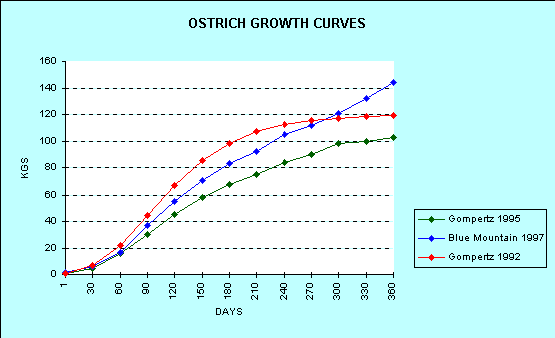
| HOME |
| About the company |
| Vitamin & Mineral Functions and Deficiencies |
| Production Terminology |
| Ostrich Benchmark Production Targets |
Email:
|
Ostrich Growth Curves
|
|
Understanding the genetic growth potential of an animal is the first requirement to achieving the correct rations to enable optimum growth. To carry out trials that are meaningful and avoid risks of giving false assumptions, it is essential to have a full history of an animal. Mainstream species have full records of genetic heritage and management for many years, so when making a small change for testing, a meaningful result is likely to be the outcome. The weight gain feed trial reported by Blue Mountain in 1996/97 took place with three separate batches of chicks. The farmer, Darrell Wagoner and his wife Barbara, are customers of Blue Mountain Feeds. They carried out the study on their own birds and provided the industry with independent benchmark figures. Click here to read details of The Blue Mountain Weight Gain Trial. The results are included on the graph below. Why are these trials so important to the industry?
1. The 1992 Gompertz Ostrich Growth Model These scientists state that “once the growth rate has been described, the nutrient requirements of the animal can be calculated.” They also state that “Gompertz models have many purposes in research to use as a tool to measure management and feeding compared to the potential growth of the animal”. 2. The 1995 Adjusted Gompertz Ostrich Growth Model 3. The 1996/97 Blue Mountain Farmer Field Trials Also worthy of note in this discussion is the fact that the Blue Mountain Feed Trials took place in Midwestern United States and the trial details reported extended periods well below freezing. Note also that this was a benchmark trial to record data to set standards to measure performance. These results were consistently achieved. Summary: References:
|
